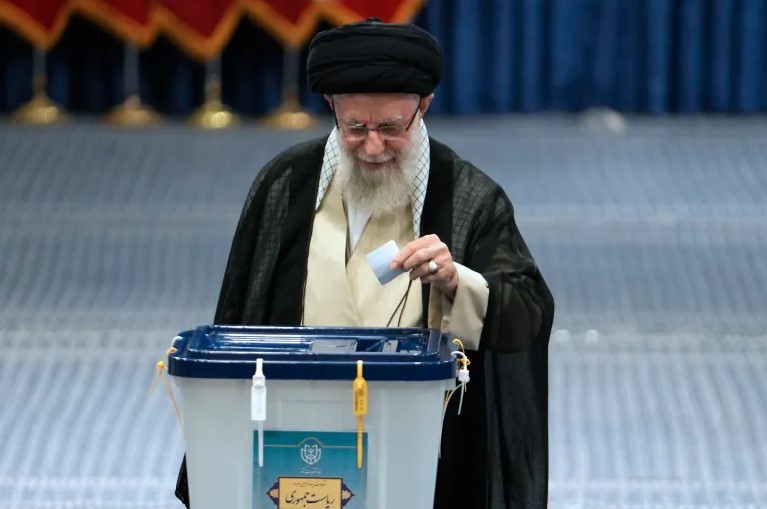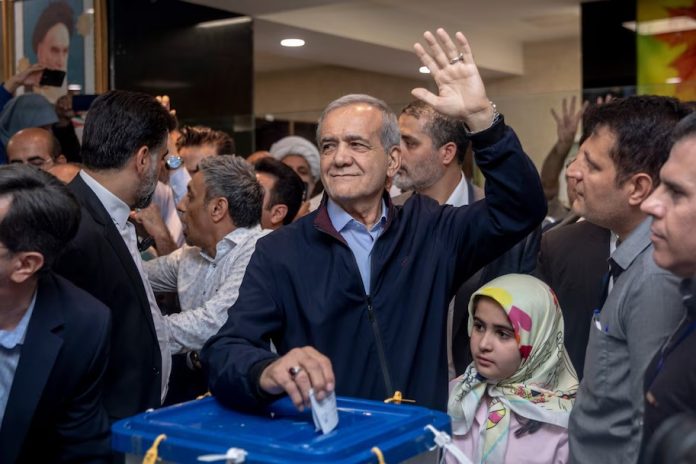Unofficial results from the Iranian election are sending the country into a presidential run-off next week, as neither hardline candidate Saeed Jalili nor moderate candidate Masoud Pezeshkian were able to secure a simple majority of the vote—50 percent plus one—required to be elected.
A Snap Election
Iran held a special election yesterday following the death of President Ebrahim Raisi, who was killed on May 19th in a helicopter crash when he was on a return trip from the border with Azerbaijan. Iran’s Minister of Foreign Affairs, Hossein Amir-Abdollahian, was also killed in the crash.
During the Guardian Council’s selection process, only six candidates advanced: Mohamed Baqer Qalibaf, Mostafa Pourmohammadi, Amirhossein Qazizadeh Hashemi, Alireza Zakani, Masoud Pezeshkian, and Saeed Jalili.

As of 12:00 p.m. local time on June 29th, Jalili, an ultraconservative hardliner, was polling at approximately 38.61 percent of the vote. Pezeshkian, a reformist, leads the polls with approximately 42.45 percent of the vote. In earlier polling, Pezeshkian had been leading before he was overtaken by Jalili. Now, Pezeshkian is back in the lead with a noticeable edge over his opponent.
????? ???? ???????? ????????????
?? ???? ?????????: ???????? ???
????? ???????: ????????
???? ?????: ???????
???????? ???????: ???????
????? ????????: ?????? pic.twitter.com/Ix62ssDhWP— ??? (@SharghDaily) June 29, 2024
Official results for the election are unlikely to be released until Sunday.
The striking doctrinal differences between Jalili and Pezeshkian demonstrate a notable divide among Iranian voters. Pezeshkian was the only moderate candidate running, with the remaining four being hardliners similar to Jalili.
Voter turnout defied even pessimistic predictions While no official numbers were released, voter turnout was estimated to be around 40 percent of eligible voters, which follows a record low in Iran that had been set during parliamentary elections in March. If voter turnout stays at around 40 percent, the presidential election will set a new record low, beating the 40.64 percent that was recorded in March.
This low turnout was despite extended hours for polling stations across Iran and calls from Iran’s Supreme Leader, Ayatollah Ali Khamenei, for a “maximum” turnout.
“The durability, strength, dignity and reputation of the Islamic Republic depend on the presence of people. High turnout is a definite necessity.” -Ayatollah Ali Khamenei
A Historic Low
While there are several likely reasons for low turnout, two are most prominent.
The first is that there is increasing apathy amongst the Iranian people for the democratic processes within the country, the legitimacy of which is called into question by many foreign observers.
Secondly, there is growing discontent with the nation’s governance among the Iranian people, largely spurred on by the 2022–2023 protests that erupted in Iran after the death of Jina (also known as Mahsa) Amini, who died in the custody of Iran’s ‘morality police’, after being arrested and beaten for improperly wearing her hijab, which is mandated under Iranian law.
Her death resulted in massive protests throughout Iran, the largest the nation had seen since the 1979 Islamic Revolution. The government cracked down harshly on the protestors, killing hundreds and arresting thousands.
While the protests eventually subsided, many of Iran’s youth have not forgotten the harsh government crackdown.
Notably, Pezeshkian has criticized the state’s crackdowns on protestors during this time, and to the general actions of the morality police, as “immoral.” Pezeshkian leading the polls as Iran moved toward a runoff could indicate dissatisfaction of the populace with these policies.

